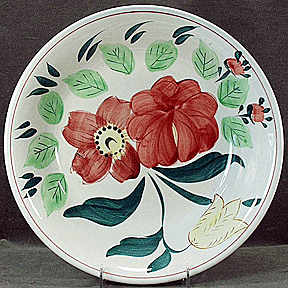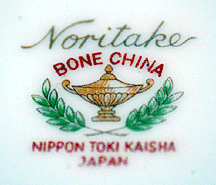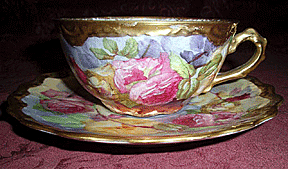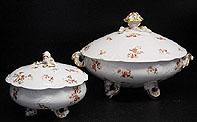Judging
the Age of China
Can Be a Fool's Errand
by Bob Brooke
 Collecting
china can be as challenging as collecting glassware. The myriad
varieties of china, as well as the huge number of companies that produce
it, make for some confusing times for collectors who try to judge its
age. The Chinese first produced porcelain during the 14th century,
but it wasn’t until 300 years later in 1604 that a Dutch ship captured
a Portuguese carrack, the Catharina, returning from a voyage to China
loaded with 100,000 pieces of porcelain. The Dutch East India Company
auctioned them off in Amsterdam, calling them “Chinese porcelains,”
which, over time, became shortened to just “china.” Collecting
china can be as challenging as collecting glassware. The myriad
varieties of china, as well as the huge number of companies that produce
it, make for some confusing times for collectors who try to judge its
age. The Chinese first produced porcelain during the 14th century,
but it wasn’t until 300 years later in 1604 that a Dutch ship captured
a Portuguese carrack, the Catharina, returning from a voyage to China
loaded with 100,000 pieces of porcelain. The Dutch East India Company
auctioned them off in Amsterdam, calling them “Chinese porcelains,”
which, over time, became shortened to just “china.”
In china as in glass, a collector must know the
characteristics of the old wares in order to avoid mistakes. A collector
of porcelain has to learn, for his or her own protection, when factories
made hard-paste and when they made soft-paste porcelains if he or she is
to be fairly sure that a piece is the age claimed for it. This
information is equally important to anyone who has a piece of china to
sell. The type and quantity of decoration, as well as the colors that
were used and the changes that took place from time to time, are
essential knowledge for judging the age of porcelain and pottery.
Using Marks for I.D.
 Potters' marks may be helpful, but aren’t
necessarily conclusive. They can, and have been known to, be erased or
altered. Crossed swords have been incorporated into the Meissen mark
since that factory first made porcelain in the 1740's. From time to time
the overall appearance of the Meissen mark was changed somewhat,
although the company retained the two swords. But crossed swords-or what
seems to be crossed swords, at first glance have been used by other
factories for their marks. If the intention was to fool buyers into
thinking they were getting porcelain of Meissen quality, it probably
succeeded some of the time. A collector who likes Haviland china should
become familiar with the various marks used by this firm during the
1800's so that he or she can date a piece fairly accurately.
Potters' marks may be helpful, but aren’t
necessarily conclusive. They can, and have been known to, be erased or
altered. Crossed swords have been incorporated into the Meissen mark
since that factory first made porcelain in the 1740's. From time to time
the overall appearance of the Meissen mark was changed somewhat,
although the company retained the two swords. But crossed swords-or what
seems to be crossed swords, at first glance have been used by other
factories for their marks. If the intention was to fool buyers into
thinking they were getting porcelain of Meissen quality, it probably
succeeded some of the time. A collector who likes Haviland china should
become familiar with the various marks used by this firm during the
1800's so that he or she can date a piece fairly accurately.
 Some patterns of tableware have been made continuously
or intermittently for 100 to 200 years. In the case of Meissen Onion, a
popular pattern among collectors, it has been made by the same factory.
However, the basic pattern differed slightly from time to time, as did
the mark of the factory. Awareness of changes and of what they were is
essential to identifying early and late-19th-century examples. The
Willow pattern was made by many different potteries. Here again, the
mark-or lack of one-can be important in judging the antiquity of the
piece. Some patterns of tableware have been made continuously
or intermittently for 100 to 200 years. In the case of Meissen Onion, a
popular pattern among collectors, it has been made by the same factory.
However, the basic pattern differed slightly from time to time, as did
the mark of the factory. Awareness of changes and of what they were is
essential to identifying early and late-19th-century examples. The
Willow pattern was made by many different potteries. Here again, the
mark-or lack of one-can be important in judging the antiquity of the
piece.
Graniteware, often called ironstone china, was popular
in the United States between 1850 and 1890. Reproductions of many of the
pieces that made up a set of tableware have been made during the last
decade. The collector who comes across some pieces and would like to
sell them cannot determine a fair price without consulting someone
expert enough to decide whether they are antiques or reproductions. The
collector also needs to learn enough about graniteware to be reasonably
certain of buying 19th-century pieces.
Copies of Copies
Quite generally copied in china are the old figures,
flowers, vegetables, and fruits, and tureens in the form of birds or
animals. Sometimes the reproductions are made from old molds and the
decoration done by modern methods. Antique gilding, for example, is a
rich gold color, not brassy or bright. The handpainting on antique
pieces is so skillful that details appear sharp when they're looked at
under a magnifying glass.
 Reproductions of figures and other ornaments are one
thing--imitations something else again. The Delft of Holland has been
imitated in other countries, and the copies may be almost impossible to
recognize unless a collector checks the potter's mark or unless the
country of origin is stated under the potter's mark. Reproductions of figures and other ornaments are one
thing--imitations something else again. The Delft of Holland has been
imitated in other countries, and the copies may be almost impossible to
recognize unless a collector checks the potter's mark or unless the
country of origin is stated under the potter's mark.
Perhaps no kind of pottery has been more widely
imitated than jasperware. The finest examples always have been made by
the Wedgwood pottery in England, where this ware was perfected. The
quality excels even that of jasperware made by European potteries during
the 18th century, and, of course, the blue and white unglazed stoneware
from Japan in this century is in no way comparable.
To read
more of my articles, please
visit
my Web site.
<
Back to Antiques Articles Next Article > |
